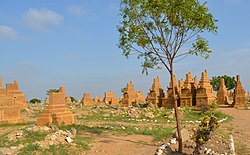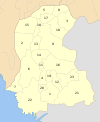District of Sindh in Pakistan
| Malir District ضلع ملیر | |
|---|---|
| District of Sindh | |
  Top: Chaukhandi tombs Top: Chaukhandi tombsBottom: Kirthar National Park | |
 Seal Seal | |
 Map of Malir District Map of Malir District | |
| Country | |
| Province | |
| Division | Karachi |
| Headquarters | Malir |
| Preceded | District Karachi East (1972-1996) |
| Established | 1996; 29 years ago (1996) |
| Abolished | 2001; 24 years ago (2001) |
| Restored | 11 July 2011; 13 years ago (11 July 2011) |
| Administration | DMC Malir |
| Administrative Subdivisions |
06
|
| Government | |
| • Type | District Administration |
| • Body | Government of Karachi |
| • Deputy Commissioner | Irfan Salam Mirwani |
| • Constituensy | NA-229 Karachi Malir-I NA-230 Karachi Malir-II NA-231 Karachi Malir-III |
| Area | |
| • District of Sindh | 2,160 km (830 sq mi) |
| Elevation | 11 m (36 ft) |
| Population | |
| • District of Sindh | 2,419,736 |
| • Density | 1,100/km (2,900/sq mi) |
| • Urban | 1,155,058 |
| • Rural | 1,264,678 |
| Demonym | Karachiite |
| Time zone | UTC+05:00 (PKT) |
| • Summer (DST) | DST is not observed |
| ZIP Code | 75050 |
| NWD (area) code | 021 |
| ISO 3166 code | PK-SD |
| CNIC Code of Malir District | 42501-XXXXXXX-X |
| Website | dcmalir |
Malir District (Urdu: ضلع ملير) is an administrative district of Karachi Division in Sindh, Pakistan created in 1996 by bifurcation of District Karachi East. According to the 2023 Pakistani census, District Malir had a population of 2,419,736 (2.4 million).
History

Before the independence of Pakistan, there were small villages of Sindhi and Kalmati Baloch in Gadap Town and Malir Town of modern Karachi. Now both towns have developed as the suburbs of the city because of the urban sprawl.
Countryside
Malir has been regarded in history as the countryside of Karachi City due to its open atmosphere and lush green farms, but now these are no more.
Agriculture land
Malir was once famous for its fruit and vegetable farms; but, now due to severe scarcity of groundwater, these farmlands are being converted into residential areas, thus increasing urbanization and environmental degradation. The Society for Conservation and Protection of Environment (SCOPE) has been concerned about drought and desertification in Malir district and has launched a campaign against illegal sand and gravel mining in the dry river beds of the Malir and its tributaries. Sand and gravel mining cause lowering of ground water, as rainwater cannot percolate in the aquifer. SCOPE is developing rainwater reservoirs in drought affected rural areas.
Administrative status
Malir District was established in 1996.
Malir District was abolished in 2000 and divided into three towns namely:
- Malir Town,
- Bin-Qasim Town
- and Gadap Town.
On 11 July 2011, Sindh Government restored again Malir District.
In 2022, a/c to Local Election Act -2022 (amended), Malir District was divided into three "Town Municipal Corporation" namely:
Headed by its elected chairman and a vice-chairman.
and also 6 subdivisions namely:
- Airport
- Bin-Qasim
- Gadap Town
- Ibrahim Hyderi Town
- Shah Mureed
- Murad Memon Goth
Each subdivision's headed by an Assistant Commissioner.
Demographics
| Year | Pop. | ±% p.a. |
|---|---|---|
| 1961 | ... | — |
| 1972 | ... | — |
| 1981 | ... | — |
| 1998 | 914,765 | — |
| 2017 | 1,924,346 | +3.99% |
| 2023 | 2,432,248 | +3.98% |
| Sources: | ||
As of the 2023 census, Malir district has 421,426 households and a population of 2,432,248. The district has a sex ratio of 112.70 males to 100 females and a literacy rate of 63.14%: 67.74% for males and 57.84% for females. 624,172 (25.8% of the surveyed population) are under 10 years of age. 1,166,340 (47.95%) live in urban areas.
| Religions in Malir district (2023) | ||||
|---|---|---|---|---|
| Religion | Percent | |||
| Islam | 96.45% | |||
| Christianity | 1.82% | |||
| Hinduism | 1.66% | |||
| Other or not stated | 0.07% | |||
The majority religion is Islam, with 96.45% of the population. Christianity is practiced by 1.82% and Hinduism (including Scheduled Castes) is practiced by 1.66% of the population.
Languages
Languages of Malir district (2023)
Sindhi (34.98%) Pashto (17.71%) Balochi (7.88%) Punjabi (9.94%) Urdu (15.79%) Hindko (5.69%) Saraiki (3.22%) Others (4.79%)At the time of the 2023 census, 34.98% of the population spoke Sindhi, 17.71% Pashto, 15.79% Urdu, 9.94% Punjabi, 7.88% Balochi, 5.69% Hindko and 3.22% Saraiki as their first language.
See also
- Malir Development Authority
- Malir (disambiguation)
- Malir Expressway Project
- Malir River
- Malir Cantonment
- Malir Cantonment railway station
References
- "Contact Us". dcmalir.sindh.gov.pk. Retrieved 31 December 2023.
- "Core Team". dcmalir.sindh.gov.pk. Retrieved 31 December 2023.
- ^ "7th Population and Housing Census - Detailed Results: Table 1" (PDF). Pakistan Bureau of Statistics.
- "From Zardaris to Makranis: How the Baloch came to Sindh". The Express Tribune. 27 March 2014. Retrieved 18 October 2020.
- "Save the Green Belt of Malir". The Nation. 18 August 2019. Retrieved 18 October 2020.
- "SCOPE - Society for Conservation and Protection of Environment". www.scope.org.pk. Retrieved 7 March 2022.
- Five districts of Karachi restored, notification issued Geo TV News website, Published 11 July 2011, Retrieved 7 March 2022
- "Karachi to have 26 towns, 233 union bodies under Sindh LG Act". Business Recorder (newspaper). 9 January 2022. Retrieved 22 January 2023.
- "Population by administrative units 1951-1998" (PDF). Pakistan Bureau of Statistics.
- "7th Population and Housing Census - Detailed Results: Table 20" (PDF). Pakistan Bureau of Statistics.
- "7th Population and Housing Census - Detailed Results: Table 12" (PDF). Pakistan Bureau of Statistics.
- "7th Population and Housing Census - Detailed Results: Table 5" (PDF). Pakistan Bureau of Statistics.
- ^ "7th Population and Housing Census - Detailed Results: Table 9" (PDF). Pakistan Bureau of Statistics.
- ^ "7th Population and Housing Census - Detailed Results: Table 11" (PDF). Pakistan Bureau of Statistics.
25°05′46″N 67°11′14″E / 25.0960°N 67.1871°E / 25.0960; 67.1871
| Districts of Sindh | ||
|---|---|---|
| Provincial capital: Karachi | ||
| Hyderabad |  | |
| Karachi | ||
| Larkana | ||
| Mirpur Khas | ||
| Shaheed Benazir Abad | ||
| Sukkur | ||